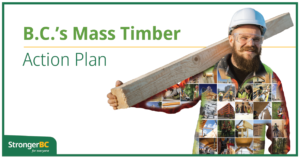
B.C. increases mass timber options for buildings
By Adam Freill
Construction Construction Materials Green ConstructionProvince is adopting building code changes that will allow for use of mass timber in wider range of buildings, and up to 18 storeys.
With an aim to build faster and more sustainably, British Columbia is adopting building-code changes to permit the use of mass timber in more types of buildings, including schools, shopping centres and housing.
The province says updates to the B.C. Building Code will benefit people in the building and housing sectors with the expanded use of mass timber.
“These changes will help reduce carbon pollution, support the forestry sector, create jobs, build more homes and lead to more vibrant communities,” said Ravi Kahlon, the province’s minister of housing. “We know mass timber looks great, and now we can use it in larger buildings and more types of buildings.”
The mass-timber updates to the B.C. Building Code, which are now in effect, allow for taller encapsulated mass-timber construction (EMTC) buildings with as many as 18 storeys for residential and office buildings. This is an increase from the previous 12-storey limit.
The changes also expand EMTC to new building types, including schools, libraries, retail, light- and medium-industrial occupancies, and care facilities. Exposed Mass timber options has also been increased, based on a building’s height and use.
“This is another step forward for British Columbia’s world-class mass-timber sector as we continue to accelerate the adoption of this strong, clean building technology,” said Jagrup Brar, Minister of State for Trade, and chair of the Mass Timber Advisory Council. “Through our Mass Timber Action Plan, we are diversifying both our forestry and construction industries to build a strong, clean and sustainable economy that works for people.”
The B.C. Building Code changes for mass timber were developed by a national joint task group co-chaired by B.C. and Quebec. Changes were reviewed by an expert technical advisory group with representation from multiple provinces, the fire services community, fire safety engineers, technical building code experts, regulators and industry.
Other provinces are expected to follow B.C.’s lead and adopt these changes into their building codes, with the changes also being submitted into the national code system for future consideration for the national building codes.





